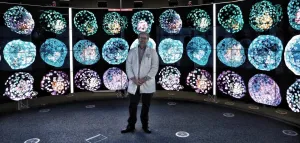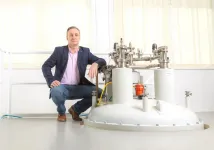(Press-News.org) A recent study shows that lettuce can be grown in greenhouses that filter out wavelengths of light used to generate solar power, demonstrating the feasibility of using see-through solar panels in greenhouses to generate electricity.
"We were a little surprised - there was no real reduction in plant growth or health," says Heike Sederoff, co-corresponding author of the study and a professor of plant biology at North Carolina State University. "It means the idea of integrating transparent solar cells into greenhouses can be done."
Because plants do not use all of the wavelengths of light for photosynthesis, researchers have explored the idea of creating semi-transparent organic solar cells that primarily absorb wavelengths of light that plants don't rely on, and incorporating those solar cells into greenhouses. Earlier work from NC State focused on how much energy solar-powered greenhouses could produce. Depending on the design of the greenhouse, and where it is located, solar cells could make many greenhouses energy neutral - or even allow them to generate more power than they use.
But, until now, it wasn't clear how these semi-transparent solar panels might affect greenhouse crops.
To address the issue, researchers grew crops of red leaf lettuce (Lactuca sativa) in greenhouse chambers for 30 days - from seed to full maturity. The growing conditions, from temperature and water to fertilizer and CO2 concentration, were all constant - except for light.
A control group of lettuces was exposed to the full spectrum of white light. The rest of the lettuces were dived into three experimental groups. Each of those groups was exposed to light through different types of filters that absorbed wavelengths of light equivalent to what different types of semi-transparent solar cells would absorb.
"The total amount of light incident on the filters was the same, but the color composition of that light was different for each of the experimental groups," says Harald Ade, co-corresponding author of the study and the Goodnight Innovation Distinguished Professor of Physics at NC State.
"Specifically, we manipulated the ratio of blue light to red light in all three filters to see how it affected plant growth," Sederoff says.
To determine the effect of removing various wavelengths of light, the researchers assessed a host of plant characteristics. For example, the researchers paid close attention to visible characteristics that are important to growers, grocers and consumers, such as leaf number, leaf size, and how much the lettuces weighed. But they also assessed markers of plant health and nutritional quality, such as how much CO2 the plants absorbed and the levels of various antioxidants.
"Not only did we find no meaningful difference between the control group and the experimental groups, we also didn't find any significant difference between the different filters," says Brendan O'Connor, co-corresponding author of the study and an associate professor of mechanical and aerospace engineering at NC State.
"There is also forthcoming work that delves into greater detail about the ways in which harvesting various wavelengths of light affects biological processes for lettuces, tomatoes and other crops," Sederoff says.
"This is promising for the future of solar-powered greenhouses," Ade says. "Getting growers to use this technology would be a tough argument if there was a loss of productivity. But now it is a simple economic argument about whether the investment in new greenhouse technology would be offset by energy production and savings."
"Based on the number of people who have contacted me about solar-powered greenhouses when we've published previous work in this space, there is a lot of interest from many growers," O'Connor says. "I think that interest is only going to grow. We've seen enough proof-of-concept prototypes to know this technology is feasible in principle, we just need to see a company take the leap and begin producing to scale."
INFORMATION:
The paper, "Balancing Crop Production and Energy Harvesting in Organic Solar Powered Greenhouses," will appear March 17 in the journal Cell Reports Physical Science. Co-lead authors of the paper are NC State Ph.D. students Melodi Charles and Eshwar Ravishankar. The paper was co-authored by Yuan Xiong, a research assistant at NC State; Reece Henry and Ronald Booth, Ph. D. students at NC State; Jennifer Swift, John Calero and Sam Cho, technicians at NC State; Taesoo Kim, a research scientist at NC State; Yunpeng Qin and Carr Hoi Yi Ho, postdoctoral researchers at NC State; Franky So, Walter and Ida Freeman Distinguished Professor of Materials Science and Engineering at NC State; Aram Amassian, an associate professor of materials science and engineering at NC State; Carole Saravitz, a research associate professor of plant biology at NC State; Jeromy Rech and Wei You of the University of North Carolina at Chapel Hill; and Alex H. Balzer and Natalie Stingelin of the Georgia Institute of Technology.
The work was done with support from the National Science Foundation under grants 1639429 and 1905901; the Office of Naval Research, under grants N00014-20-1-2183, N00014-17-1-2242 and N00014-17-1-2204; North Carolina State University; and NextGen Nano Limited.
AUSTRALIAN - LED INTERNATIONAL RESEARCH TEAM GENERATES THE FIRST MODEL OF EARLY HUMAN EMBRYOS FROM SKIN CELLS
In a discovery that will revolutionize research into the causes of early miscarriage, infertility and the study of early human development - an international team of scientists led by Monash University in Melbourne, Australia has generated a model of a human embryo from skin cells.
The team, led by Professor Jose Polo, has successfully reprogrammed these fibroblasts or skin cells into a 3-dimensional cellular structure that is morphologically and molecularly similar to human blastocysts. Called iBlastoids, these can be used to model the biology of ...
What The Study Did: Racial and ethnic disparities in very preterm birth and preterm birth among 8,026 women were similar during the first wave of the COVID-19 pandemic in New York City compared with the same period the year prior in this observational study.
Authors: Teresa Janevic, Ph.D., M.P.H., of the Icahn School of Medicine at Mount Sinai in New York, is the corresponding author.
To access the embargoed study: Visit our For The Media website at this link https://media.jamanetwork.com/
(doi:10.1001/jamanetworkopen.2021.1816)
Editor's Note: The article includes conflict of interest and funding/support disclosures. Please see the article ...
Using artificial intelligence and mobile digital microscopy, researchers hope to create screening tools that can detect precursors to cervical cancer in women in resource-limited settings. A study led by researchers at Karolinska Institutet in Sweden now shows that AI screenings of pap smears carried out with portable scanners were comparable to analyses done by pathologists. The results are published in the journal JAMA Network Open.
"Our method enables us to more effectively discover and treat precursors to cervical cancer, especially in low-income countries, where there is a serious lack of skilled pathologists ...
BOSTON - Most surgical patients with a history of penicillin allergy can safely be given the guideline-recommended antibiotic cefazolin to prevent infection instead of several penicillin alternatives that are less effective and more expensive, according to a study conducted by Massachusetts General Hospital (MGH), the University of Colorado Anschutz Medical Campus and the University of Porto in Portugal. The researchers reported in JAMA Surgery that the frequency of allergies to both penicillins and cefazolin was so small that most patients should receive cefazolin regardless of their allergy history.
"Under current practice, ...
UPTON, NY--Electrons in a solid occupy distinct energy bands separated by gaps. Energy band gaps are an electronic "no man's land," an energy range where no electrons are allowed. Now, scientists studying a compound containing iron, tellurium, and selenium have found that an energy band gap opens at a point where two allowed energy bands intersect on the material's surface. They observed this unexpected electronic behavior when they cooled the material and probed its electronic structure with laser light. Their findings, reported in the Proceedings of the National Academy of Sciences, could have implications for future quantum information ...
March 17, 2021 - In recent years, hospital charges and Medicare payments for patients with hip fractures have increased much more rapidly than charges and payments for orthopaedic surgeons, reports a study in the Journal of Orthopaedic Trauma. The journal is published in the Lippincott portfolio by Wolters Kluwer.
The gap in Medicare reimbursements to hospitals compared to surgeons widened substantially in the last decade - even as patient outcomes improved and healthcare resource use decreased, according to a new analysis by Brian Werner, MD, and colleagues of UVA Health, Charlottesville, Va. "The results confirm our hypothesis that hospital charges and payments contribute significantly more to the increasing cost of treating a hip fracture patient than surgeon ...
He and his research group have found a way to more precisely determine the properties of these materials, because they can better account for the underlying disorder. Their article has been designated "ACS Editors' Choice" by the editors of the American Chemical Society journals, who recognise the "importance to the global scientific community" of the Leipzig researchers' work and see it as a breakthrough in the accurate description of phase transition phenomena in disordered porous materials.
In mesoporous materials, the pore openings are far smaller than in a normal sponge: their diameters range from 2 to 50 nanometres and are invisible to the naked eye. Nevertheless, they have a number of interesting properties, including with ...
The abundance and other characteristics of rocks partially extending above the water surface could be important for improving the recovery of aquatic insect populations in restored streams.
Nearly three quarters of stream insects reproduce on large rocks that sit above the water surface by crawling underneath to attach their eggs. Increasing the number of large and stable emergent rocks in streams could provide more egg-laying habitat and allow insects to quickly repopulate restored streams.
"We found that restored streams had fewer emergent rocks for egg-laying and fewer total eggs than naturally intact streams," says Samantha Jordt, first author of the paper and an M.Sc. student at NC State's Department of Applied Ecology.
The study also ...
Simple systems can reproduce faster than complex ones. So, how can the complexity of life have arisen from simple chemical beginnings? Starting with a simple system of self-replicating fibres, chemists at the University of Groningen have discovered that upon introducing a molecule that attacks the replicators, the more complex structures have an advantage. This system shows the way forward in elucidating how life can originate from lifeless matter. The results were published on 10 March in the journal Angewandte Chemie.
The road to answering the question of how life originated is guarded by Spiegelman's monster, named after the American molecular biologist Sol Spiegelman, who some 55 years ago ...
Many people who embrace social welfare programs vote against their own interests, according to new UC Riverside research.
The mitigating factor is education: The more education one has, the more likely one is to stick to one's policy preferences.
"It means candidates who employ tactics such as fear and attaching patriotism to certain concepts can persuade people to vote for candidates who are in opposition to their social beliefs," Diogo Ferrari, a professor of political science at UC Riverside, wrote in his recently published paper, "Education, Belief Structures, Support for Welfare Polices, and Vote," published in the journal Education & Society.
For the study, Ferrari looked at public opinion ...






